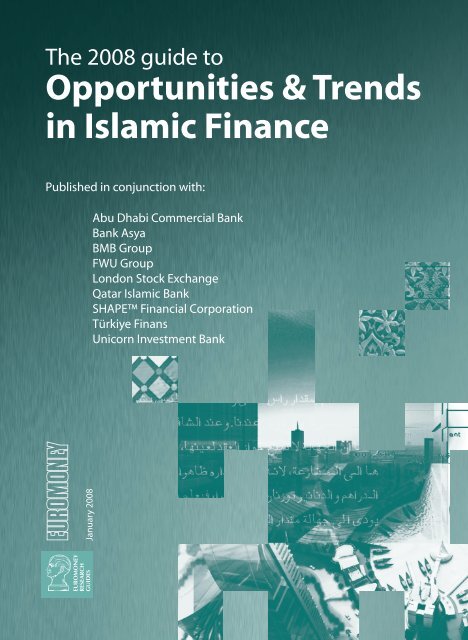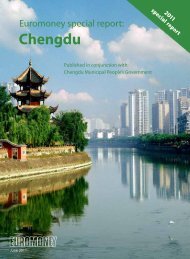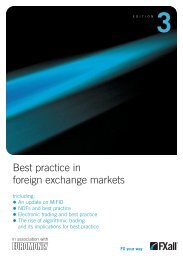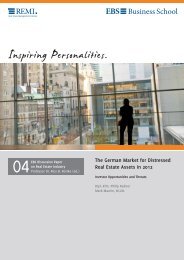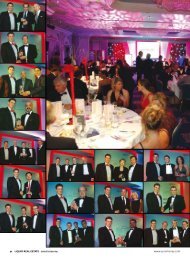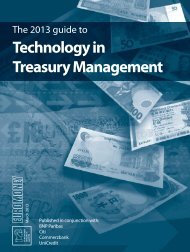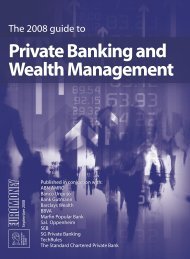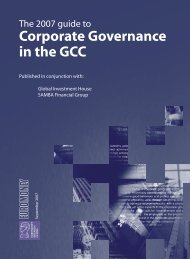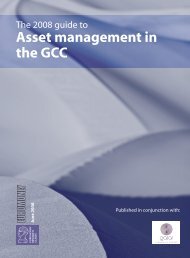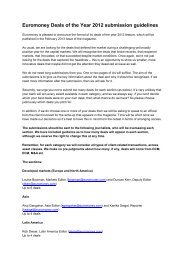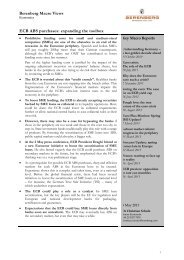Opportunities & Trends in Islamic Finance - Euromoney
Opportunities & Trends in Islamic Finance - Euromoney
Opportunities & Trends in Islamic Finance - Euromoney
- No tags were found...
Create successful ePaper yourself
Turn your PDF publications into a flip-book with our unique Google optimized e-Paper software.
The 2008 guide to<strong>Opportunities</strong> & <strong>Trends</strong><strong>in</strong> <strong>Islamic</strong> F<strong>in</strong>ancePublished <strong>in</strong> conjunction with:Abu Dhabi Commercial BankBank AsyaBMB GroupFWU GroupLondon Stock ExchangeQatar <strong>Islamic</strong> BankSHAPE F<strong>in</strong>ancial CorporationTürkiye F<strong>in</strong>ansUnicorn Investment BankJanuary 2008
ContentsIntroduction: 2Expand<strong>in</strong>g the frontiers of <strong>Islamic</strong> f<strong>in</strong>anceBy Abdulkader ThomasParticipation bank<strong>in</strong>g: 4A grow<strong>in</strong>g sector <strong>in</strong> TurkeyBank AsyaLondon acts as global gateway for 6<strong>Islamic</strong> f<strong>in</strong>anceLondon Stock Exchange<strong>Islamic</strong> capital markets: 8Still break<strong>in</strong>g recordsBy Philip MooreThe potential of Bancatakaful 14FWU GroupThis guide is for the use of professionals only. It states the position of themarket as at the time of go<strong>in</strong>g to press and is not a substitute for detailed localknowledge.<strong>Euromoney</strong> Institutional Investor PLCNestor HousePlayhouse YardLondon EC4V 5EXTelephone: +44 20 7779 8888Facsimile: +44 20 7779 8739 / 8345Directors: Padraic Fallon (chairman and editor-<strong>in</strong>-chief ), Sir Patrick Sergeant,The Viscount Rothermere, Richard Ensor (manag<strong>in</strong>g director), C.J. S<strong>in</strong>clair, NeilOsborn, Dan Cohen, Christopher Brown, J P Williams, John Botts, Col<strong>in</strong> Jones,Simon Brady, Tom Lamont, Gary Mueller, Diane Alfano, Mike Carroll, ChristopherFordham, Jamie Gonzalez, Jane Wilk<strong>in</strong>sonEditor: Sarah M<strong>in</strong>nsDirector of research guides: Mike CarrodusCover illustration: Garrett FallonPr<strong>in</strong>ted <strong>in</strong> the United K<strong>in</strong>gdom by: St Ives, Roche, UK© <strong>Euromoney</strong> Institutional Investor PLC London 2007<strong>Euromoney</strong> is registered as a trademark <strong>in</strong> the United States and the UnitedK<strong>in</strong>gdom.
Expand<strong>in</strong>g the frontiers of<strong>Islamic</strong> f<strong>in</strong>ance2007 was a year of achievement for <strong>Islamic</strong> f<strong>in</strong>ance, with growth on all fronts. Yet the sector stillfaces great challenges, not least <strong>in</strong> f<strong>in</strong>d<strong>in</strong>g and tra<strong>in</strong><strong>in</strong>g enough <strong>Islamic</strong> bankersThe <strong>Islamic</strong> f<strong>in</strong>ance <strong>in</strong>dustry has never enjoyed a year like 2007. Inevery market and every aspect, the providers of <strong>Islamic</strong> f<strong>in</strong>ancial solutionshave surpassed their past achievements. They have grown thebalance sheets of <strong>Islamic</strong> banks by 40% <strong>in</strong> 2007; more than quadrupledthe issuance of new sukuk; expanded to new frontiers, and improvedevery aspect of their bus<strong>in</strong>ess <strong>in</strong> established markets.But the <strong>in</strong>dustry faces three great challenges if it is truly to expand itsfrontiers: are there sufficient qualified people; are <strong>Islamic</strong> and regionalbanks able to pick up the slack created by retreat<strong>in</strong>g global banks, andwill regulators implement the rules that allow a well-ordered bus<strong>in</strong>essto compete on a level play<strong>in</strong>g field? Even if 2007 was a great year, thepromise will not be buoyed by high oil prices, rather by elbow grease.The Sukuk spaceSlowly, the Saudi Arabian market is awaken<strong>in</strong>g to the opportunity touse sukuk for corporate f<strong>in</strong>ance. Although the Capital Markets Authorityhas not yet issued sukuk rules, important corporates such as SABIC,Saudi Consolidated Electricity Company (SCECO), Dar Al Arkan and theSaad group have issued. More will follow. The large issuances of SABICand SCECO were placed domestically, demonstrat<strong>in</strong>g the capacity forfund<strong>in</strong>g <strong>in</strong> the local market: an important omen for the future. GivenFigure 1: GCC vs Malaysia value of Sukuk issues, 2005-2007Total value of issues, $bln35302520151050GCCMalaysiaNumber of issues20052006 2007the comparison of population and GDP between Saudi Arabia and Malaysia,one can only imag<strong>in</strong>e that the implementation of the right sukukrules <strong>in</strong> Saudi Arabia will turn that key market <strong>in</strong>to the true secondpillar of sukuk activity alongside Malaysia.The sukuk market faces other important challenges, <strong>in</strong>clud<strong>in</strong>g thegauntlet thrown down by Muhammad Taqi Usmani at the Account<strong>in</strong>gand Audit<strong>in</strong>g Organization for <strong>Islamic</strong> F<strong>in</strong>ancial Institutions (AAO-IFI) conference <strong>in</strong> November 2007. Not only Saudi Arabia, but otherimportant <strong>Islamic</strong> markets require the def<strong>in</strong>ition of rules that will allowefficient special purpose vehicles to be formed, with bankruptcy remoteness,and for the formalization of the Anglo-American concept of“true sale” under local law. These rules and other that enable the sukukmarket to its fullest only solve part of the problem. Usmani po<strong>in</strong>ted outthat many sukuk are structured <strong>in</strong> a way that makes them more like aloan than an <strong>Islamic</strong> lease or partnership; and this takes them out ofAAOIFI compliance. As a result, the market faces the new question ofwhat qualifies as a true <strong>Islamic</strong> <strong>in</strong>strument, and whether that <strong>in</strong>strumentis easily traded outside of the explicitly def<strong>in</strong>ed <strong>Islamic</strong> space.Perhaps GCC and MENA regulators need to contemplate import<strong>in</strong>g theMalaysian style of <strong>in</strong>tegrated Sharia’a oversight and regulation.Because the sukuk market is not yet efficient, despite its dynamicgrowth, the syndication market rema<strong>in</strong>s hot. Syndicated <strong>Islamic</strong>160140120100806040200Number of issuesSource: IFIS, 19 December 2007project f<strong>in</strong>ance is follow<strong>in</strong>g the same degree ofexperimentation as the sukuk market. In the pastyear, large-scale decl<strong>in</strong><strong>in</strong>g balance partnerships,forward leases, salam (forward sales of commodities)and tawarruq (an adaptation of murabaha)deals have been syndicated <strong>in</strong> the project f<strong>in</strong>anceand corporate f<strong>in</strong>ance market. This is <strong>in</strong> addition tothe cont<strong>in</strong>uously active syndicated <strong>Islamic</strong> tradef<strong>in</strong>ance market.Project demandThe <strong>Islamic</strong> project f<strong>in</strong>ance market’s opportunitiesare beyond imag<strong>in</strong>ation, whether they be <strong>in</strong>master-planned cities <strong>in</strong> almost every Middle Eastand North African country, modernization of thehydrocarbon sector on a global basis, or lateral<strong>in</strong>vestment by GCC countries <strong>in</strong>to the downstreampetrochemicals and plastics bus<strong>in</strong>ess around theworld. And, <strong>in</strong>creas<strong>in</strong>gly, many of the bus<strong>in</strong>essleaders guid<strong>in</strong>g these projects are seek<strong>in</strong>g partialor complete f<strong>in</strong>anc<strong>in</strong>g on a Sharia’a-compliant basis.This demand is help<strong>in</strong>g many <strong>Islamic</strong> <strong>in</strong>vestorsplace their funds, but it also requires the expertiseof traditional global and <strong>in</strong>vestment banks to
structure and manage the project risks and f<strong>in</strong>anc<strong>in</strong>g. With <strong>in</strong>flationarypressures and shortages of certa<strong>in</strong> build<strong>in</strong>g materials as well as<strong>in</strong>sufficient eng<strong>in</strong>eers, 2008 may see a cool<strong>in</strong>g <strong>in</strong> this sector. Worse, it isunclear how much the credit crisis <strong>in</strong> the West will cause the traditionalplayers <strong>in</strong> project f<strong>in</strong>ance to retrench and be less active at a time whenthe market is demand<strong>in</strong>g their skills.New market opportunitiesThe two great developments of the past seven years <strong>in</strong>clude the improvementof economic standards <strong>in</strong> many Muslim countries as civil orderor economic growth have been restored, and the petroleum boom.Both realities are rapidly expand<strong>in</strong>g the capabilities of Muslim savers <strong>in</strong>Africa and Southeast and South Asia, as well as the MENA region. The<strong>in</strong>creas<strong>in</strong>gly sophisticated Muslim consumer is demand<strong>in</strong>g comparableservices at a fair value from <strong>Islamic</strong> providers. The result has been theemergence of a robust takaful sector with both regional and globalplayers provid<strong>in</strong>g robust and <strong>in</strong>novative solutions.Takaful is the <strong>Islamic</strong> alternative to traditional <strong>in</strong>surance, and its growthis creat<strong>in</strong>g demand for new and better asset management solutions. Awide variety of new products and adaptations of new products is be<strong>in</strong>g<strong>in</strong>troduced to the market. These range from efforts to execute betterwith pla<strong>in</strong> vanilla products to highly debated structured products andderivatives that some are test<strong>in</strong>g <strong>in</strong> the <strong>Islamic</strong> market. On the onefor <strong>Islamic</strong> bankers and <strong>in</strong>vestment bankers. The best way to characterizethe four qualifications now available is as a good start. But noth<strong>in</strong>gyet blends a practical, multil<strong>in</strong>gual approach to provid<strong>in</strong>g prospectiveand practis<strong>in</strong>g <strong>Islamic</strong> bankers with the correct balance of Sharia’aunderstand<strong>in</strong>g and bank<strong>in</strong>g knowledge. Moreover, many are geared towardspeople with a certa<strong>in</strong>, relatively high job functionality or highereducation. With the current growth of <strong>Islamic</strong> bank<strong>in</strong>g and f<strong>in</strong>ance,too many tasks from the back office to the CEO’s job are performed bytalented people whose understand<strong>in</strong>g of Sharia’a ground rules is simplistic.The directors of the lead<strong>in</strong>g <strong>Islamic</strong> <strong>in</strong>stitutions need to elevatethe role of comprehensive assessment based tra<strong>in</strong><strong>in</strong>g to the forefrontof their agendas.ConclusionWill the credit crunch deflate our hopes for 2008? The many achievementsof 2007 are built on a deep cooperation between the lead<strong>in</strong>gglobal f<strong>in</strong>ancial <strong>in</strong>stitutions from the West and the <strong>Islamic</strong> f<strong>in</strong>ancialsector. If the global banks falter due to the credit crunch, one mustask whether <strong>Islamic</strong> banks and <strong>in</strong>vestment banks have the ability andthe capacity to pick up the slack. In the sukuk market, two importantevents are giv<strong>in</strong>g contradictory answers. Although the fund<strong>in</strong>g forSABIC I and SCECO was largely from Saudi Arabian <strong>in</strong>vestors, the organizationof the deals came from HSBC. This causes one to wonder if theGCC and MENA markets are ready. Important bankers say yes, but we“In every GCC market and Malaysia, every aspect of consumer and corporatef<strong>in</strong>ancial services is addressed by an <strong>Islamic</strong> choice. This growth of alternativesis giv<strong>in</strong>g depth to the market and assur<strong>in</strong>g its long-term stability”hand, the demand for better and more sophisticated <strong>in</strong>vest<strong>in</strong>g is be<strong>in</strong>gmet by more and more providers <strong>in</strong> the takaful and asset managementfields. On the other hand, the surplus of cash among <strong>Islamic</strong> <strong>in</strong>vestors iscaus<strong>in</strong>g experimentation that is challeng<strong>in</strong>g on every frontier.But the market is enjoy<strong>in</strong>g new developments of significance. Countrieslike Turkey and Egypt, formerly less at the frontier of <strong>Islamic</strong>f<strong>in</strong>ance, are mov<strong>in</strong>g forward. Significant new <strong>in</strong>vestments by GCC<strong>Islamic</strong> <strong>in</strong>vestors <strong>in</strong>to Turkey, Egypt, Pakistan, the UK and Indonesia arebr<strong>in</strong>g<strong>in</strong>g life to these markets and creat<strong>in</strong>g new opportunities for thefuture of both the <strong>in</strong>bound monies and the <strong>in</strong>vestors themselves.Although some analysts believe that the volume of new <strong>Islamic</strong> banks,f<strong>in</strong>ance companies, <strong>in</strong>vestment banks and funds is unsusta<strong>in</strong>able, thereality is that consumer choice is w<strong>in</strong>n<strong>in</strong>g. But the real mean<strong>in</strong>g is that<strong>in</strong> every GCC market and Malaysia, every aspect of consumer and corporatef<strong>in</strong>ancial services is addressed by an <strong>Islamic</strong> choice. This growthof alternatives is giv<strong>in</strong>g depth to the market and assur<strong>in</strong>g its long-termstability.The people challengeNonetheless, there rema<strong>in</strong>s one great challenge. There are not enough<strong>Islamic</strong> bankers to go around. And, there is no accepted qualificationhaven’t seen the market <strong>in</strong> action without the global banks. In contrast,the robust Malaysian sukuk market enjoys the participation of foreignbanks, but does not rely on them to lead or fund deals. Surely the talentand funds exist <strong>in</strong> the global <strong>Islamic</strong> market, and it can function withthe scaled down role of global banks. Indeed, the <strong>in</strong>itiative, whether <strong>in</strong>Pakistan, ASEAN countries or the MENA/GCC region to address takaful,asset management and consumer needs is almost completely homegrown - which leads to the as yet unfulfilled need for better and more<strong>in</strong>tegrated tra<strong>in</strong><strong>in</strong>g.For further <strong>in</strong>formation, please contactAbdulkader ThomasPresident & CEOSHAPE F<strong>in</strong>ancial Corp.Vienna, Virg<strong>in</strong>ia & Kuwait CityEmail: <strong>in</strong>fo@shapef<strong>in</strong>ancial.comINTRODUCTION • Expand<strong>in</strong>g the frontiers of <strong>Islamic</strong> f<strong>in</strong>ance
Participation bank<strong>in</strong>g: Agrow<strong>in</strong>g sector <strong>in</strong> TurkeyS<strong>in</strong>ce its <strong>in</strong>troduction <strong>in</strong> 1985, participation (<strong>in</strong>terest free) bank<strong>in</strong>g has grown rapidly <strong>in</strong> Turkey, withlocal, Middle East and <strong>in</strong>ternational <strong>in</strong>stitutions all <strong>in</strong>troduc<strong>in</strong>g products to meet the demand. In its11-year history, Bank Asya has firmly established itself as one of the leaders <strong>in</strong> the fieldParticipation (<strong>in</strong>terest free) bank<strong>in</strong>g was <strong>in</strong>troduced to Turkey <strong>in</strong> 1985via the establishment of two f<strong>in</strong>ance houses, follow<strong>in</strong>g the government’sspecial legislation on <strong>in</strong>terest-free bank<strong>in</strong>g, issued <strong>in</strong> December1983. By the end of 1996, the establishment of Bank Asya took the totalof these f<strong>in</strong>ance houses to six.Similar to other <strong>Islamic</strong> banks around the world, participation banks <strong>in</strong>Turkey offer their customers profit-shar<strong>in</strong>g proceeds <strong>in</strong>stead of <strong>in</strong>terestand charge borrowers participation-shar<strong>in</strong>g <strong>in</strong>stead of loan <strong>in</strong>terest -hence the name participation bank. The holders of accounts share boththe profits and losses that result from <strong>in</strong>vestment of their funds. At theend of the <strong>in</strong>vestment activity, profits are shared between the banksand account holders, and the banks can get a maximum of 20% of theprofits. After deduction of the banks’ share from the accru<strong>in</strong>g profits,the balance is paid to the holders prior to maturity.The participation banks offer their clients a full range of productsjust like commercial banks <strong>in</strong>clud<strong>in</strong>g collection services, credit anddebit cards and personal loans <strong>in</strong> retail bank<strong>in</strong>g; cash management,production support, POS and other electronic bank<strong>in</strong>g services <strong>in</strong>SME bank<strong>in</strong>g; general corporate f<strong>in</strong>ance, project f<strong>in</strong>ance <strong>in</strong> corporatebank<strong>in</strong>g and f<strong>in</strong>ally trade f<strong>in</strong>ance, structured f<strong>in</strong>ance and <strong>in</strong>ternationalsyndications <strong>in</strong> <strong>in</strong>ternational bank<strong>in</strong>g.Bank Asya: a key playerOne of the key players <strong>in</strong> the market is Bank Asya. Established on 10 October1996 as a Turkish private f<strong>in</strong>ance house, Bank Asya ranks amongthe top 15 banks <strong>in</strong> Turkey by asset size, with total assets reach<strong>in</strong>g USD3.1 billion as of year-end 2006, and market share of approximately 1.2%of the total bank<strong>in</strong>g market <strong>in</strong> Turkey. The bank is the largest amongthe four participation banks <strong>in</strong> Turkey, with a 30% market share.Asya is subject to the Turkish Bank<strong>in</strong>g Act and the regulations of theBank<strong>in</strong>g Regulation and Supervision Agency and Sav<strong>in</strong>gs DepositInsurance Fund. The latter <strong>in</strong>stitution was established to, among otherth<strong>in</strong>gs, <strong>in</strong>sure deposits and manage and/or liquidate distressed or<strong>in</strong>solvent banks. Bank Asya was the first special f<strong>in</strong>ance house to beawarded the ISO 9001 Quality Management System Certificate.Participation banks are authorized by the Bank<strong>in</strong>g Act to collectdeposit funds from the public under the profit-and-loss participationaccounts and special current accounts. The profit-and-loss accountsare a version of the <strong>Islamic</strong> f<strong>in</strong>ance <strong>in</strong>strument, where the bank utilizesthe funds deposited by account holders as an accumulated poolfor specific bus<strong>in</strong>ess activities. Any profits or losses (typically 80%)are shared between the account holder and the bank, <strong>in</strong> an agreedproportion.In addition to participation banks, there are a grow<strong>in</strong>g number of <strong>in</strong>stitutionsfrom the Middle East that have a presence <strong>in</strong> Turkey, such asDubai <strong>Islamic</strong> Bank, ABC <strong>Islamic</strong>, and Amlak F<strong>in</strong>ance. International f<strong>in</strong>ancial<strong>in</strong>stitutions such as HSBC, BNP Paribas, Calyon, Citibank, ABN Amro,Citibank and Deutsche Bank also offer <strong>Islamic</strong> products alongside theirconventional offer<strong>in</strong>gs, highlight<strong>in</strong>g the grow<strong>in</strong>g appetite for suchproducts among Turkish clients.The Turkish Participation Banks Association (TKBB) estimates thatassets held by participation banks, as an <strong>in</strong>tegral part of the Turkishbank<strong>in</strong>g system, have grown by 740%, whereas loans have grown 800%s<strong>in</strong>ce 2000. The Turkish participation bank<strong>in</strong>g sector, employ<strong>in</strong>g just under10,000 people and with over 400 branches throughout the country,has grown at a consistent rate of approximately 40% a year s<strong>in</strong>ce 2001and at the end of 2006 and the Participation Banks constituted 3.25%of the bank<strong>in</strong>g system <strong>in</strong> terms of asset size, 5.4% <strong>in</strong> terms of lend<strong>in</strong>gand 3.9% <strong>in</strong> terms of deposits. It is estimated that the assets of participationbanks <strong>in</strong> Turkey will exceed $25 billion, up from $8.5 billion, <strong>in</strong>the next decade and will account for 10% of the whole bank<strong>in</strong>g system.As the lead<strong>in</strong>g participation bank <strong>in</strong> Turkey, Asya’s assets grew fromUSD 1.9 billion at the end of 2005 to USD 3.1 billion at the end of 2006.This cont<strong>in</strong>uous expansion is an <strong>in</strong>dicator of the demand for <strong>in</strong>terestfreef<strong>in</strong>ancial products and services <strong>in</strong> Turkey.Bank Asya has been assigned long and short-term foreign currencyrat<strong>in</strong>gs of B with a positive outlook by Fitch Rat<strong>in</strong>gs. Asya was the firstparticipation bank <strong>in</strong> Turkey to receive a rat<strong>in</strong>g from Fitch as part of itseffort for full transparency. Asya also holds a Ba1 rat<strong>in</strong>g from Moody’s.Bank Asya has been the fastest-grow<strong>in</strong>g <strong>in</strong>digenous bank s<strong>in</strong>ce 2001,enjoy<strong>in</strong>g a return on equity employed of 31%, the highest <strong>in</strong> the sector.It operates with 120 branches situated across Turkey. The bank also hasjo<strong>in</strong>t agreements with other Turkish Banks and serves the <strong>in</strong>dividualclient base through more than 4500 ATM mach<strong>in</strong>es. Asya serves morethan 1 million retail clients with Hous<strong>in</strong>g and Car loans, <strong>in</strong>stallment plans,credit and debit cards and <strong>in</strong>surance services. Currently the bank has700,000 credit card holders with a target of 1 million which would beeasily surpassed with the first quarter of 2008.
Figure 1: Bank Asya Key f<strong>in</strong>ancial ratios and other <strong>in</strong>formationforeign trade. Of total enterprises <strong>in</strong> Turkey, 99.8% are SMEs, and it isanticipated that this sector will <strong>in</strong>crease leverage go<strong>in</strong>g forward.Profitability Ratios2004 2005 2006Return on Average Equity 25.84% 40.6% 31.1%Return on Average Assets 2.11% 4% 3.9%Capital AdequacyCapital Adequacy Ratio 10.78% 13.06% 18.6%Other InformationEmployees 1.333 1.797 2.328Branches 62 72 92Source: International F<strong>in</strong>ancial Report<strong>in</strong>g Standard Chartered BankRecord-break<strong>in</strong>g IPOBank Asya completed its <strong>in</strong>itial public offer<strong>in</strong>g of 20% of its shares onthe Istanbul Stock Exchange (ISE) <strong>in</strong> May 2006. A further 3% green shoeoption was later exercised, br<strong>in</strong>g<strong>in</strong>g the total to 23%. Currently, 43% ofAsya’s shares are publicly traded on the ISE. Bank Asya is the first participationbank to be listed on the exchange and its IPO was one of themost sought-after offers s<strong>in</strong>ce the establishment of the stock market<strong>in</strong> Turkey: the most successful IPO to date with 52 times oversubscriptionof the allotment of shares, valu<strong>in</strong>g the bank at $800 million. Theoffer<strong>in</strong>g was for $180 million with the green shoe option and strongdemand came from Europe, US and Middle East, besides domestic<strong>in</strong>vestors, totall<strong>in</strong>g a massive $7.5 billion. Six months after the IPO, BankAsya’s shares became part of the prestigious ISE-30 Index. The <strong>in</strong>itiationprice of Bank Asya shares was YTL 3.5 <strong>in</strong> May 2006 and the current priceis YTL 11 valu<strong>in</strong>g the bank at US $2.7 billion.Asya’s overall strategy is to cont<strong>in</strong>ue to compete <strong>in</strong> the Turkish bank<strong>in</strong>gsector as a whole, rather than just with other participation banks. Todo this, Asya aims to <strong>in</strong>troduce <strong>in</strong>terest-free bank<strong>in</strong>g products to thebroadest possible customer base.In anticipation of the present <strong>in</strong>terest rate environment, Asya’sstrategy has been, and will cont<strong>in</strong>ue to be, to expand the bus<strong>in</strong>ess <strong>in</strong>the more profitable segments such as commercial bank<strong>in</strong>g and to <strong>in</strong>creasefee and commission <strong>in</strong>come to offset lower mark-up marg<strong>in</strong>s.Other areas for particular focus <strong>in</strong>clude project and trade f<strong>in</strong>anc<strong>in</strong>g.Regard<strong>in</strong>g the latter, economic growth <strong>in</strong> Turkey has led to significant<strong>in</strong>creases <strong>in</strong> <strong>in</strong>ternational trade activity. While Asya’s current marketshare <strong>in</strong> Turkey’s <strong>in</strong>ternational trade stands at approximately 2.1%,it is seek<strong>in</strong>g to expand it over the next few years. As far as projectf<strong>in</strong>anc<strong>in</strong>g is concerned, Asya aims to establish itself as the lead<strong>in</strong>gprovider for energy <strong>in</strong>frastructure projects.SME focusAs at the end 2006, the total amount of outstand<strong>in</strong>g cash loans to commercialcustomers, consist<strong>in</strong>g of corporate and SME customers, representedapproximately 88% of the total cash loan portfolio. This compareswith approximately 90% at the end of December 2005.The bank enjoys acorporate client base of more than 90,000 of which 88% are SMEs.The SME sector <strong>in</strong> Turkey is under-banked, with an estimated 6–8 %stake <strong>in</strong> the total sector loans. Bank Asya’s strategic focus s<strong>in</strong>ce itsestablishment has been the SME sector, together with retail clients andBank Asya also provides a broad range of leas<strong>in</strong>g products to supportits commercial clients’ needs. S<strong>in</strong>ce conventional banks are not allowedunder Turkish law to engage directly <strong>in</strong> leas<strong>in</strong>g activities, Asya,as a participation bank, can conduct leas<strong>in</strong>g activities more efficientlythan conventional banks operat<strong>in</strong>g through their subsidiaries. Asyaenjoys a strong place among top 5 banks <strong>in</strong> terms of off-balancesheet risk <strong>in</strong> the Turkish Bank<strong>in</strong>g system and generates 45% of itscommission earn<strong>in</strong>gs from non-cash loans. Asya also enters <strong>in</strong>tocerta<strong>in</strong> f<strong>in</strong>ancial <strong>in</strong>struments with off-balance sheet risk to meet theneeds of customers. These <strong>in</strong>clude letters of guarantee, acceptancecredit and import letters of credit, along with other commitments andliabilities.International relationshipsInternational activities consist pr<strong>in</strong>cipally of establish<strong>in</strong>g and ma<strong>in</strong>ta<strong>in</strong><strong>in</strong>gbus<strong>in</strong>ess relationships with correspondent banks <strong>in</strong> foreigncountries. In recent years there has been a focus on <strong>in</strong>ternational operationsdesigned to <strong>in</strong>crease domestic market share, expand productand risk differentiation, ga<strong>in</strong> a greater presence <strong>in</strong> global f<strong>in</strong>ancialmarkets and meet the chang<strong>in</strong>g needs of exist<strong>in</strong>g and potential customers.Asya ma<strong>in</strong>ta<strong>in</strong>s active bus<strong>in</strong>ess relationships with more than850 correspondent banks <strong>in</strong> nearly 100 countries.In April 2007, Bank Asya tapped <strong>in</strong>to the syndication market for thefisrt time with a murabaha f<strong>in</strong>anc<strong>in</strong>g facility. 3 MLA’s were mandatedfor US $50 million and after achiev<strong>in</strong>g a significant oversubscriptionfrom correspondents all over the world, the facility was <strong>in</strong>creased toUS $175 million. The deal was two tranches with a maximum tenorof 2 years. 40 banks participated to support Bank Asya with manyof them enter<strong>in</strong>g such an islamic deal for the first time from US andEurope.S<strong>in</strong>ce 2002, Asya has placed a great deal of emphasis on its <strong>in</strong>ternationaltrade activities, with special attention be<strong>in</strong>g paid to thecontract<strong>in</strong>g sector and its foreign projects. With its strong presence <strong>in</strong>the f<strong>in</strong>ance sector and this large correspondent base, Bank Asya hassecured its place as one of the leaders <strong>in</strong> <strong>in</strong>ternational trade f<strong>in</strong>anceamong all banks and f<strong>in</strong>ancial <strong>in</strong>stitutions <strong>in</strong> Turkey.For further <strong>in</strong>formation, please contactMr. Unsal SOZBIRExecutive Vice PresidentKucuksu Cad. Akcakoca SokakNo:6 Umraniye 34768 IstanbulTurkeyTel: +90 216 633 5120Usozbir@bankasya.com.trBANK ASYA • Paticipation bank<strong>in</strong>g: a grow<strong>in</strong>g sector <strong>in</strong> Turkey
London acts as globalgateway for <strong>Islamic</strong> f<strong>in</strong>anceAs a global f<strong>in</strong>ancial centre, London could be expected to play a part <strong>in</strong> the development of <strong>Islamic</strong><strong>in</strong>vestment products. The London Stock Exchange’s markets are <strong>in</strong>creas<strong>in</strong>gly attractive to thosewish<strong>in</strong>g to <strong>in</strong>vest or raise funds <strong>in</strong> a Shariah-compliant wayGiven London’s place at the heart of the <strong>in</strong>ternational f<strong>in</strong>ancial marketsit is not surpris<strong>in</strong>g that a significant part of the recent, rapid growth <strong>in</strong><strong>Islamic</strong> f<strong>in</strong>ance has taken place there. The London Stock Exchange playsa key part <strong>in</strong> the City’s development as a global gateway for <strong>Islamic</strong> f<strong>in</strong>anceand now offers <strong>Islamic</strong> <strong>in</strong>vestors from Brita<strong>in</strong> and beyond accessto a grow<strong>in</strong>g range of Shari’ah-compliant products.S<strong>in</strong>ce the start of 2006 the exchange has admitted14 sukuk to trad<strong>in</strong>gon its markets, rais<strong>in</strong>g <strong>in</strong> excess of £5 billion. This year it welcomedthe UK’s first Shari’ah-compliant exchange-traded funds (ETFs). Theexchange’s capital markets are also play<strong>in</strong>g an important role <strong>in</strong> f<strong>in</strong>anc<strong>in</strong>gthe development of companies from around the world, <strong>in</strong>clud<strong>in</strong>gthe Middle East.Capital pool<strong>Islamic</strong> issuers are drawn to London for a variety of reasons. While thedesire to access the world’s most <strong>in</strong>ternational pool of capital is crucial,the City’s pr<strong>in</strong>ciples-based approach to regulation and the wide rangeof expertise offered by London-based professionals are also importantattractions.The prospects for the future development of the <strong>Islamic</strong> f<strong>in</strong>ancial<strong>in</strong>dustry <strong>in</strong> the UK are good. London’s deep and liquid markets, excellentskills base and s<strong>in</strong>gle f<strong>in</strong>ancial services regulator, which is regarded<strong>in</strong>ternationally as respond<strong>in</strong>g flexibly and pragmatically to new ideas,all help to create an environment sympathetic to the needs of <strong>Islamic</strong>f<strong>in</strong>ance. This is be<strong>in</strong>g recognized by a number of <strong>in</strong>ternational banks,such as Citibank, UBS and HSBC, which have chosen to set up their<strong>Islamic</strong> bank<strong>in</strong>g and advisory activities <strong>in</strong> London.Government supportIn addition, with Muslims account<strong>in</strong>g for 3% of the UK’s population, thegovernment has s<strong>in</strong>ce 2000 <strong>in</strong>troduced a series of tax and legislativechanges designed to remove obstacles to the development of <strong>Islamic</strong>f<strong>in</strong>ance, <strong>in</strong> a bid to create an <strong>in</strong>clusive f<strong>in</strong>ancial system. In 2004 the UKbecame the first country to authorize a wholly <strong>Islamic</strong> retail bank <strong>in</strong> acountry where most of the population is non-Muslim. That bank, the <strong>Islamic</strong>Bank of Brita<strong>in</strong>, along with the European <strong>Islamic</strong> Investment Bank,is now quoted on AIM. The government’s tax and legislative frameworkhas also established a level play<strong>in</strong>g field for a variety of other <strong>Islamic</strong>products, <strong>in</strong>clud<strong>in</strong>g mortgages, bonds and <strong>in</strong>surance.The exchange’s markets offer flexibility: <strong>in</strong>ternational companies canchoose to issue a wide variety of different security types <strong>in</strong> London,<strong>in</strong>clud<strong>in</strong>g shares, depositary receipts, sukuk and debt. Internationalissuers also have a choice from a number of markets, <strong>in</strong>clud<strong>in</strong>g theexchange’s flagship ma<strong>in</strong> market; the Professional Securities Market,which is designed for the needs of professional <strong>in</strong>vestors; or the AlternativeInvestment Market (AIM), for smaller grow<strong>in</strong>g companies.Nearly 40 companies from the Middle East have opted to raise capitalon the London Stock Exchange’s markets, <strong>in</strong>clud<strong>in</strong>g a number of banksand f<strong>in</strong>ancial services companies.Good news for <strong>in</strong>vestorsThe growth of <strong>Islamic</strong> f<strong>in</strong>ance <strong>in</strong> London is not just good for the City. Itis also excellent news for the grow<strong>in</strong>g number of Muslim <strong>in</strong>vestors fromaround the world now access<strong>in</strong>g the exchange’s markets. In December,iShares chose to issue its first Shari’ah-compliant ETFs on the LondonStock Exchange’s ma<strong>in</strong> market, for the first time allow<strong>in</strong>g these <strong>in</strong>vestorsto benefit from the low-cost, <strong>in</strong>stant diversification offered by arange of ETFs while <strong>in</strong>vest<strong>in</strong>g <strong>in</strong> a way that is consistent with Shari’ahpr<strong>in</strong>ciples. With a typical total expense ratio of 0.85%, the iShares MSCIWorld <strong>Islamic</strong>; the iShares MSCI Emerg<strong>in</strong>g Markets <strong>Islamic</strong> and theiShares MSCI USA <strong>Islamic</strong> ETFs offer a cost-effective way to build an<strong>Islamic</strong> <strong>in</strong>vestment portfolio.The London Stock Exchange is part of HM Treasury’s <strong>Islamic</strong> F<strong>in</strong>ance ExpertsGroup, which was established <strong>in</strong> April 2007 to advise the governmenton opportunities to support the development of <strong>Islamic</strong> f<strong>in</strong>ance<strong>in</strong> the UK. The group is exam<strong>in</strong><strong>in</strong>g the feasibility of the UK governmentbecom<strong>in</strong>g the first national government <strong>in</strong> Europe to issue a sovereignsukuk. With the government and the City actively promot<strong>in</strong>g <strong>Islamic</strong>f<strong>in</strong>ance, the foundations for the further development of the <strong>in</strong>dustry <strong>in</strong>the UK have been firmly laid.For further <strong>in</strong>formation, please contactDarko HajdukovicProduct Manager – Ma<strong>in</strong> Market and Professional SecuritiesMarketThe London Stock ExchangeTel: + 44 (0) 20 7797 3306Email: dhajdukovic@londonstockexchange.com
The BMB The Group BMB is Group proud is to proud be one to of be the one world’s of the lead<strong>in</strong>g world’s <strong>Islamic</strong> lead<strong>in</strong>g f<strong>in</strong>ancial <strong>Islamic</strong> f<strong>in</strong>ancial <strong>in</strong>stitutions. <strong>in</strong>stitutions. The BMB The BMBGroup The The BMB was BMB Group Group established was established proud proud to to provide to be to be one to be one f<strong>in</strong>ancial provide one of of the of the the f<strong>in</strong>ancial world’s services lead<strong>in</strong>g services and asset <strong>Islamic</strong> and management asset f<strong>in</strong>ancial management <strong>in</strong>stitutions. a truly pan-<strong>Islamic</strong> a truly The The BMB pan-<strong>Islamic</strong>BMBstructure Group structure was that was established operates that operates with to to to provide a non-competitive with f<strong>in</strong>ancial a non-competitive services philosophy and philosophy and asset to asset encourage management to encourage fruitful <strong>in</strong> <strong>in</strong> a <strong>in</strong> a partnerships fruitful truly a truly pan-<strong>Islamic</strong>partnerships with withlocal structure <strong>Islamic</strong> local that that <strong>Islamic</strong> and operates conventional and with with a conventional a non-competitive a <strong>in</strong>stitutions <strong>in</strong>stitutions worldwide. philosophy worldwide. to We to to encourage focus We on focus fruitful the <strong>Islamic</strong> on partnerships the <strong>Islamic</strong> <strong>in</strong>vestmentwith<strong>in</strong>vestment withmanagement local local <strong>Islamic</strong> management and and f<strong>in</strong>ancial and conventional and f<strong>in</strong>ancial advisory <strong>in</strong>stitutions advisory needs of needs some worldwide. of the some most We of We the significant We focus most focus on significant on rul<strong>in</strong>g the on the the <strong>Islamic</strong> families, rul<strong>in</strong>g <strong>in</strong>vestmentfamilies, high net high networth management <strong>in</strong>dividuals, worth and <strong>in</strong>dividuals, and governments f<strong>in</strong>ancial governments advisory and <strong>in</strong>stitutions needs needs and of of <strong>in</strong>stitutions of some of some of the of the of the <strong>Islamic</strong> of the most the most world. <strong>Islamic</strong> significant We world. provide rul<strong>in</strong>g rul<strong>in</strong>g We families, these provide exclusivehigh these high net netexclusive net<strong>in</strong>vestors worth worth <strong>in</strong>dividuals, <strong>in</strong>vestors with an with unsurpassed governments an unsurpassed <strong>in</strong>vestment and and <strong>in</strong>stitutions <strong>in</strong>vestment advisory of of the of the advisory platform, the <strong>Islamic</strong> platform, world. comb<strong>in</strong><strong>in</strong>g We We comb<strong>in</strong><strong>in</strong>g We provide the resources these these resources exclusiveof the of theworld’s <strong>in</strong>vestors most world’s with significant with most unsurpassed significant f<strong>in</strong>ancial f<strong>in</strong>ancial <strong>in</strong>vestment powerhouses.powerhouses.advisory platform, comb<strong>in</strong><strong>in</strong>g the the the resources of of the of thetheworld’s most most significant f<strong>in</strong>ancial powerhouses.The Americas The AmericasNew York New Yorkc/o The The BMB The AmericasAdvisors Americas c/o BMB Ltd. Advisors Ltd.New 399 New Park York New YorkAvenue, York 399 Park 39th Avenue, Floor 39th Floorc/o New c/o BMB York, BMB c/o BMB Advisors NY New Advisors 10022 Ltd. York, Ltd.USA Ltd. NY 10022 USA399 T: 399 +1 Park 212 399 Park 317 Park Avenue, T: 8800 Avenue, +1 39th 212 39th F: Floor +1 317 39th Floor212 8800 Floor 317 F: 9081 +1 212 317 9081New New York, New York, York, NY NY 10022 NY 10022 10022 USA USAUSAT: T: +1 T: +1 +1 212 T: 212 +1 317 212 317 8800 317 8800 8800 F: F: +1 F: +1 +1 212 F: 212 +1 317 212 317 9081 317 90819081Europe & The Europe Middle & East The Middle EastLondon Londonc/o Europe BMB Europe & Advisors & The The c/o & The BMB Middle UK Middle Ltd. Advisors East EastEast UK Ltd.2 St LondonJames's London Place 2 St James's Placec/o London, c/o BMB BMB c/o SW1A BMB Advisors London, Advisors 1NR UK UK United SW1A Ltd. UK Ltd.Ltd. K<strong>in</strong>gdom 1NR United K<strong>in</strong>gdom2 T: St 2 +44 St St 2 James's 207 St James's 491 Place T: Place1664 +44 Place 207 F: +44 491207 1664491 F: 1688 +44 207 491 1688London, London, SW1A SW1A 1NR 1NR 1NR United United K<strong>in</strong>gdomK<strong>in</strong>gdomT: T: +44 T: +44 T: 207 +44 207 491 207 491 1664 491 1664 1664 F: F: +44 F: +44 F: 207 +44 207 491 207 491 1688 491 16881688Asia AsiaBrunei Darussalam Brunei Darussalamc/o Asia AsiaThe Asia Withanage c/o The Group Withanage GroupBrunei The Brunei Empire, Brunei DarussalamJerudong, The Empire, Jerudong,c/o BSB c/o The Brunei The c/o The Withanage Darussalam BSB Withanage Brunei GroupGroup DarussalamThe T: The +673 The Empire, 2 611 Empire, T: 481 Jerudong,+673 Jerudong, T: 2 +673 611 2481 611 T: 595 +673 2 611 595BSB BSB BSB Brunei Brunei DarussalamT: T: +673 T: +673 T: 2 +673 611 2 611 2481 611 481 T: 481 T: +673 T: +673 T: 2 +673 611 2 611 2595611 595595
<strong>Islamic</strong> capital markets: stillbreak<strong>in</strong>g recordsThe slowdown <strong>in</strong> the global capital market has yet to dent the <strong>Islamic</strong> sector, with the value ofsukuk deals doubl<strong>in</strong>g <strong>in</strong> 2007. Indications are that the vast <strong>in</strong>frastructure <strong>in</strong>vestments planned forthe Middle East and South Asia will help keep the trend on an upward pathFor the <strong>Islamic</strong> market, 2007 was another year of impressive growth,despite the sharp slowdown at the primary level of the global capitalmarket. By mid-December, total issuance <strong>in</strong> the sukuk market hadreached a record $43 billion <strong>in</strong> 177 deals, accord<strong>in</strong>g to data published byIFIS. Although this represented a decrease on the total number of transactionscompleted the previous year (199), it represented an <strong>in</strong>creaseof 80% on the amount raised <strong>in</strong> the global sukuk market <strong>in</strong> 2006, whendeals worth $27 billion were completed. That total compares with $12billion <strong>in</strong> 2005 and just $7 billion <strong>in</strong> 2004.Chart 1: Global sukuk issuance (US$ mn)50,00045,00043,13940,00035,00030,00027,16625,00020,00015,00012,03410,0007,2115,7175,0002003 2004 2005 2006 2007Source: IFIS 19 Dec 2007issuance from Africa and (predom<strong>in</strong>antly) the Middle East <strong>in</strong> 2007. In2006, borrowers <strong>in</strong> the Africa and Middle East region raised a over $10billion <strong>in</strong> the global sukuk market; <strong>in</strong> 2007, this rose to almost $20 billion.In Malaysia, by contrast – which is comfortably the ma<strong>in</strong> source of Asiansukuk issuance – total volumes rose around 40% from $15 billion <strong>in</strong> 2006to $21 billion <strong>in</strong> 2007.With<strong>in</strong> the Middle East, the most strik<strong>in</strong>g development <strong>in</strong> 2007 was thevery clear emergence of the United Arab Emirates (UAE) as the centreof gravity for issuance of sukuk. In 2006, six UAE-based borrowers raised$21.435 billion <strong>in</strong> the sukuk market, with issuance driven by a smallhandful of very large transactions. Those <strong>in</strong>cluded the highly successful$3.5 billion Dubai Ports deal at the start of 2006, led by Barclays Capitaland Dubai <strong>Islamic</strong> Bank, and the $3.52 billion transaction for Nakheel atthe end of the year, led by the same banks. In 2007, however, volumes<strong>in</strong> the UAE market for sukuk transactions exploded to $22.276 billion <strong>in</strong>26 transactions.Elsewhere <strong>in</strong> the GCC, issuance <strong>in</strong> Saudi Arabia posted a healthy rate ofgrowth from $818 million <strong>in</strong> 2006 to over $5 billion <strong>in</strong> 2007, althoughby December. Foremost among those transactions is the $4.1 billiontransaction for the fast-grow<strong>in</strong>g National Air Services (NAS), which <strong>in</strong>2007 placed orders for 98 new aircraft as part of a growth strategy thatwill see its total fleet expand to 142 planes by 2012.Beh<strong>in</strong>d the aggregate totals, however, were a number of highly significanttrends. The most strik<strong>in</strong>g of these was the conspicuous <strong>in</strong>crease <strong>in</strong>Another fast-grow<strong>in</strong>g market is Qatar, where total issuance was lessthan $270 million <strong>in</strong> 2006. In 2007, announced or issued volumeChart 2: Sukuk issuance by countryKuwait 3%Pakistan 2%Bahra<strong>in</strong> 2%2006 2007Other 2%Brunei 1%Saudi Arabia 3%Pakistan 1%Brunei 2%Bahra<strong>in</strong> 3%Other 2%Saudi Arabia 13%Kuwait 4%Malaysia50%UAE 31%Malaysia54%UAE 27%Source: IFIS 19 Dec 2007
expanded Table 1: to Largest more than Sukuks $5 billion, <strong>in</strong> 2007buoyedchiefly by a $2.5 billion dealThat was most graphically illustrated <strong>in</strong> June, when Malaysia’s stateISSUER COUNTRY TYPE AMOUNT (US$ MN)Aldar Properties United Arab Emirates <strong>Islamic</strong> Exchangeable Bond 2,530DP World United Arab Emirates Mudharabah 1,500Dubai International F<strong>in</strong>ancial Center United Arab Emirates Mudharabah 1,250Dana Gas United Arab Emirates Mudharabah 1,000Dar Al Arkan Saudi Arabia Sukuk Al Ijara 1,000Khazanah Nasional Malaysia <strong>Islamic</strong> Exchangeable Bond 850Nakheel United Arab Emirates <strong>Islamic</strong> Exchangeable Bond 750Dubai <strong>Islamic</strong> Bank United Arab Emirates Sukuk Al Musharakah 750Dar Al Arkan Saudi Arabia Sukuk Al Ijara 600National Industries Group Kuwait Mudharabah 475Source: IFIS, 19 December 2007announced <strong>in</strong> the summer by the Qatar Gas Transportation Company(Nakilat), to support the company’s acquisition of 54 new tankers fordelivery <strong>in</strong> 2010. With other borrowers such as Barwa Real Estate alsoannounc<strong>in</strong>g plans to sell $800 million of <strong>Islamic</strong> bonds this year, Qataris likely to be one of the pivotal markets <strong>in</strong> the cont<strong>in</strong>ued evolution ofthe sukuk market <strong>in</strong> 2008.Among other GCC economies, issuance of sukuk has rema<strong>in</strong>ed modest<strong>in</strong> comparison with the recent explosion <strong>in</strong> the UAE. In Bahra<strong>in</strong>, for example,which s<strong>in</strong>ce the 1980s has been a key location for the evolutionof the <strong>Islamic</strong> f<strong>in</strong>ancial services <strong>in</strong>dustry, issuance <strong>in</strong> 2007 reached $973million, compared with $798 million <strong>in</strong> 2006. In Kuwait, meanwhile,volume <strong>in</strong> 2007 rose to $1.3 billion, up from a little over $1 billion theprevious year.Borrowers diversifyA number of other key trends emerged from the strik<strong>in</strong>g expansion<strong>in</strong> the sukuk market <strong>in</strong> 2007, led by issuance from the UAE. One ofthese was the cont<strong>in</strong>ued diversification of the market, giv<strong>in</strong>g <strong>in</strong>vestorsexposure to a much broader range of the GCC’s fastest-grow<strong>in</strong>gcorporate names. Many of those corporate borrowers are categorizedby the rat<strong>in</strong>gs agencies as so-called government-related enterprises,giv<strong>in</strong>g <strong>in</strong>vestors exposure to credits that some regard as offer<strong>in</strong>g quasigovernmentrisk. Prom<strong>in</strong>ent examples <strong>in</strong>clude borrowers such as DIFCInvestments and the UAE utility, Taqa.Wholly privately-owned companies com<strong>in</strong>g to the market for the firsttime <strong>in</strong> 2007, meanwhile, <strong>in</strong>cluded those such as the Saudi Arabianconglomerate, the Saad Group, which generated demand of more than$900 million for its debut transaction led <strong>in</strong> May by BNP Paribas. Thatstrong demand allowed for the five-year deal, orig<strong>in</strong>ally planned as a$350 million-500 million issue, to be upsized to $650 million.Another important trend that was especially conspicuous <strong>in</strong> the firsthalf of 2007 was the cont<strong>in</strong>ued diversification of the <strong>in</strong>vestor base forsukuk. In the early stages of the market, the lion’s share of sukuk wasgenerally placed with ‘domestic’ or regional <strong>in</strong>vestors. While the Malaysianmarket has rema<strong>in</strong>ed predom<strong>in</strong>antly a domestic one, its borrowershave enjoyed notable success <strong>in</strong> tapp<strong>in</strong>g an <strong>in</strong>creas<strong>in</strong>gly <strong>in</strong>ternationalmarket.<strong>in</strong>vestment hold<strong>in</strong>g company, Khazanah Nasional, launched itsgroundbreak<strong>in</strong>g $850 million sukuk exchangeable <strong>in</strong>to a 15% stake<strong>in</strong> the toll road operator, PLUS Expressways. Led by CIMB InvestmentBank, Deutsche Bank and JP Morgan, the Khazanah transaction was<strong>in</strong>creased from its orig<strong>in</strong>ally planned $600 million when it generatedorders of more than $7.8 billion. Much of that demand was accountedfor by convertible funds from Europe.Global <strong>in</strong>vestors targetedSukuk issuance from the Middle East has also <strong>in</strong>creas<strong>in</strong>gly beentargeted at a global <strong>in</strong>vestor community. For example, an importantlandmark for the market was passed <strong>in</strong> June 2007, when BarclaysCapital, Citigroup, Deutsche Bank and Dubai <strong>Islamic</strong> Bank led a highlysuccessful $1.5 billlion sukuk Al Mudabarah transaction for DP World.This was an <strong>in</strong>tegral part of a $3 billion fund<strong>in</strong>g programme allow<strong>in</strong>gDP World to ref<strong>in</strong>ance its exist<strong>in</strong>g debt, and broke new ground for be<strong>in</strong>gthe first sukuk to be documented to ensure compliance with RegS and US 144A standards. Accord<strong>in</strong>g to a deal analysis published byDubai <strong>Islamic</strong> Bank, that made the DP World issue the first of its k<strong>in</strong>d togive US accounts the opportunity to <strong>in</strong>vest <strong>in</strong> UAE corporate securities.In total, accord<strong>in</strong>g to the same analysis, 33% of the transaction wasplaced <strong>in</strong> the US, with a further 15% <strong>in</strong> Europe, 8% <strong>in</strong> Asia and 8% <strong>in</strong> theUK, with only 36% distributed <strong>in</strong> the Middle East.Table 2: 2007 Sukuk BookrunnersRANKING BOOKRUNNER AMOUNT (US$ MN) ISSUES1 CIMB <strong>Islamic</strong> 5,323 272 HSBC Amanah 3,808 143 Barclays Capital 2,479 64 JP Morgan 2,033 35 Deutsche Bank 1,980 66 Citigroup 1,762 57 Dubai <strong>Islamic</strong> Bank 1,102 78 Riyad Bank 1,050 19 Standard Chartered Bank 1,001 1610 Credit Suisse 960 2Source: IFIS, 19 December 2007
The grow<strong>in</strong>g diversification of the <strong>in</strong>vestor base for <strong>Islamic</strong> securities <strong>in</strong>2006, which gathered momentum <strong>in</strong> the early months of 2007, turnedout to be someth<strong>in</strong>g of a double-edged sword. International <strong>in</strong>vestorsbecame <strong>in</strong>creas<strong>in</strong>gly nervous about committ<strong>in</strong>g funds to newcorporate issuance as the credit crunch tightened its global grip <strong>in</strong> thesecond half of 2007, which had an <strong>in</strong>evitable knock-on impact on thesukuk sector at both the primary and secondary level. Issuance of newsukuk slowed <strong>in</strong> the second half of the year, while spreads of those<strong>in</strong>struments that had been widely placed among <strong>in</strong>ternational <strong>in</strong>vestorswidened. That widen<strong>in</strong>g, bankers <strong>in</strong> the Middle East rightly <strong>in</strong>sisted,was purely a reflection of global liquidity flows, rather than of any shifts<strong>in</strong> the underly<strong>in</strong>g credit quality of issuers <strong>in</strong> the sukuk space. After all,buoyed by high oil prices and economic diversification, growth <strong>in</strong> theInfrastructure prospectsLook<strong>in</strong>g to 2008 and beyond, there is a grow<strong>in</strong>g belief that one of themost excit<strong>in</strong>g areas for <strong>Islamic</strong> f<strong>in</strong>ance will be as a means of f<strong>in</strong>anc<strong>in</strong>g thegigantic <strong>in</strong>frastructure <strong>in</strong>vestments that are now either be<strong>in</strong>g implementedor are on the draw<strong>in</strong>g board throughout the Middle East. Estimates ofthe total <strong>in</strong>vestment that will be channelled by public and private sector<strong>in</strong>vestors <strong>in</strong>to <strong>in</strong>frastructure <strong>in</strong> the <strong>Islamic</strong> world vary, but a recent reportpublished by the Dubai-based Abraaj Capital describes the requirement<strong>in</strong> the Middle East, North Africa and South Asia as “noth<strong>in</strong>g shortof spectacular”. The Abraaj report says that “<strong>in</strong> the first half of 2006, theMiddle East, for the first time <strong>in</strong> its history, became the largest source of<strong>in</strong>frastructure related project f<strong>in</strong>ance <strong>in</strong> the world, account<strong>in</strong>g for $33 billion,or one dollar for every three that was raised <strong>in</strong> the <strong>in</strong>dustry globally”.“One of the most excit<strong>in</strong>g areas for <strong>Islamic</strong> f<strong>in</strong>ance will be as a means off<strong>in</strong>anc<strong>in</strong>g the gigantic <strong>in</strong>frastructure <strong>in</strong>vestments that are now either be<strong>in</strong>gimplemented or are on the draw<strong>in</strong>g board throughout the Middle East”Middle East <strong>in</strong> general and the GCC <strong>in</strong> particular cont<strong>in</strong>ues to outpacemost of the rest of the world.Over the com<strong>in</strong>g decade, adds the Abraaj analysis, the MENSA regionwill call for <strong>in</strong>frastructure <strong>in</strong>vestment of more than $630 billion acrossa number of key economic sectors. Power and utilities will account forOne notable positive by-product of the grow<strong>in</strong>g risk averseness ofglobal <strong>in</strong>vestors <strong>in</strong> the second half of 2007 was the <strong>in</strong>creased flexibilityof borrowers <strong>in</strong> the sukuk market. In the case of a transaction launched<strong>in</strong> November by the Jebel Ali Free Zone (JAFZ), led by Barclays Capital,$155 billion of this huge total, with the other areas identified as hav<strong>in</strong>gsubstantial <strong>in</strong>vestment requirements <strong>in</strong>clud<strong>in</strong>g water ($133 billion),healthcare ($49 billion), education ($18 billion), transportation ($188billion) and petrochemicals ($87 billion).Deutsche Bank, Dubai <strong>Islamic</strong> Bank and Lehman Brothers, the anticipationof weak <strong>in</strong>ternational demand did not lead to a cancellation of thedeal. Instead, it led to its denom<strong>in</strong>ation <strong>in</strong> dirham rather than dollars,with the transaction eventually offered as a very successful Dh7.5billion ($2 billion equivalent) float<strong>in</strong>g-rate note (FRN), which made theJAFZ deal the largest ever non-convertible sukuk, with local <strong>in</strong>vestorsaccount<strong>in</strong>g for 62% of distribution.Much of the focus for <strong>in</strong>vestment will <strong>in</strong>evitably be concentrated onthe Middle East, but the populous and fast-grow<strong>in</strong>g Indian economyalso has a massive <strong>in</strong>frastructure requirement. The government hasrecently put the size of that requirement at $500 billion between 2007and 2012, mean<strong>in</strong>g that some 9% of GDP will need to be <strong>in</strong>vested <strong>in</strong><strong>in</strong>frastructure over the next five years.Table 3: Key project f<strong>in</strong>anc<strong>in</strong>g transactions <strong>in</strong> 2007Project Country Sector AMOUNT (US$ mn) Type of F<strong>in</strong>anc<strong>in</strong>gIndian Economic Zone India Infrastructure 10,000 <strong>Islamic</strong> F<strong>in</strong>anc<strong>in</strong>g FacilityEnergy City Ch<strong>in</strong>a Ch<strong>in</strong>a Power 5,000 Istisna’aTunisian F<strong>in</strong>ancial Harbour Tunisia Real Estate - Commercial 3,000 <strong>Islamic</strong> F<strong>in</strong>anc<strong>in</strong>g FacilityDeyaar Park UAE Real Estate 3,000 Istisna’aSaudi Telecoms Saudi Arabia Telecommunications 2,500 Murabaha FacilityAl Raha Beach Project UAE Real Estate 2,100 IjarahLeisure & real estate projects UAE Real Estate 1,850 IjarahRoyal Metropolis Jordon Gate Jordan Real Estate - Residential 1,000 <strong>Islamic</strong> F<strong>in</strong>anc<strong>in</strong>g FacilityDurrat Al Bahra<strong>in</strong> Bahra<strong>in</strong> Real Estate - Residential 1,000 <strong>Islamic</strong> FundBarwa Real Estate expansions Qatar Real Estate 800 Murabaha FacilityDubai Bus<strong>in</strong>ess Park UAE Real Estate - Commercial 700 <strong>Islamic</strong> F<strong>in</strong>anc<strong>in</strong>g FacilityLow Sulphur Diesel Production Facility Bahra<strong>in</strong> Oil & Gas 685 IjarahQueen Alia Intl Airport Expansion Jordan Infrastructure - Airports 680 <strong>Islamic</strong> F<strong>in</strong>anc<strong>in</strong>g FacilityEthylene-Glycol Plant Saudi Arabia Petrochemical 650 Istisna’aMarafiq IWPP Saudi Arabia Water & Power Plants 600 <strong>Islamic</strong> F<strong>in</strong>anc<strong>in</strong>g FacilitySource: IFIS, 19 December 2007<strong>Islamic</strong> capital markets still break<strong>in</strong>g records11
Table 4: Ma<strong>in</strong> real estate project f<strong>in</strong>anc<strong>in</strong>g transactions signed dur<strong>in</strong>g 2007Project Obligor Country Amount (USD$ Mn) Type of F<strong>in</strong>anc<strong>in</strong>gCapital Injection Nakheel Group UAE 350 IjarahPark Corner Development Test Contract<strong>in</strong>g Company UAE 22 <strong>Islamic</strong> F<strong>in</strong>anc<strong>in</strong>g FacilityGrowth Opportunity Plans Tamweel PJSC UAE 463 <strong>Islamic</strong> F<strong>in</strong>anc<strong>in</strong>g FacilityGlomac Tower Glomac Al Batha Malaysia 23 Istisna’aLeisure & real estate projects Nakheel Group UAE 1,850 IjarahProperties <strong>in</strong> the Holy Haram area Munshaat Real Estate Company Saudi Arabia 100 Revolv<strong>in</strong>g Murabaha<strong>in</strong> Makkah & Mad<strong>in</strong>ahSource: IFIS, 19 December 2007Quantify<strong>in</strong>g how much of the world’s <strong>in</strong>frastructure <strong>in</strong>vestment willbe f<strong>in</strong>anced through <strong>Islamic</strong> <strong>in</strong>struments or <strong>Islamic</strong> project f<strong>in</strong>ance ishazardous, but IFIS puts the potential <strong>in</strong>to perspective <strong>in</strong> its analysisof completed or announced deals <strong>in</strong> 2007. In the project and <strong>in</strong>frastructuref<strong>in</strong>anc<strong>in</strong>g category, these <strong>in</strong>dicate that transactions worthalmost $56 billion had been issued or announced by mid-December2007, through a variety of <strong>in</strong>struments rang<strong>in</strong>g from sukuks to Ijara(leas<strong>in</strong>g), Istisna’a (contracts of exchange) and morabaha (trade-based)structures and more straightforward syndicated or bilateral <strong>Islamic</strong>f<strong>in</strong>anc<strong>in</strong>g facilities.Those transactions were also spread across a very diversified range ofgeographical regions. For example, the IFIS <strong>in</strong>ventory of projects signedor under construction by December 2007 <strong>in</strong>clude the $10 billion IndianEconomic Zone <strong>in</strong>itiative, a 1,600-acre zone to be developed nearMumbai and supported by an <strong>Islamic</strong> f<strong>in</strong>anc<strong>in</strong>g facility for which theBahra<strong>in</strong>-based Gulf F<strong>in</strong>ance House (GFH) has been appo<strong>in</strong>ted as mandatedlead arranger. Another project outside the Gulf be<strong>in</strong>g supportedby an Istisna’a facility is the $5 billion Energy City Ch<strong>in</strong>a development.It is, however, the GCC that accounts for the bulk of ambitious projectsunder development that are be<strong>in</strong>g f<strong>in</strong>anced <strong>in</strong> some shape or formwith structures compliant with Shariah law. The largest of these, accord<strong>in</strong>gto the IFIS data, <strong>in</strong>clude projects such as the Al Raha Beachproject <strong>in</strong> Abu Dhabi, a major mixed-use development be<strong>in</strong>g buildalongside 8.5km of natural beach-front that will house over 120,000residents. In June 2007, Dubai <strong>Islamic</strong> Bank and Morgan Stanley wereappo<strong>in</strong>ted mandated lead arrangers on a $2.1 billion facility for AldarProperties, which is develop<strong>in</strong>g the Al Raha project. In common with anumber of the region’s big-ticket project-related f<strong>in</strong>anc<strong>in</strong>gs, this wasdivided <strong>in</strong>to a $1.267 billion conventional tranche and an $833 million<strong>Islamic</strong> facility – both of which were healthily over-subscribed, with theentire package generat<strong>in</strong>g commitments of $2.84 billion.Real estate potentialIn data analyz<strong>in</strong>g the growth of the <strong>Islamic</strong> capital market, real estatef<strong>in</strong>ance is often bundled together with the broader <strong>in</strong>frastructure market,and general consensus among bankers is that residential and commercialmortgage-backed structures are likely to develop <strong>in</strong>to a verypromis<strong>in</strong>g area for <strong>Islamic</strong> f<strong>in</strong>ance. Throughout much of the MiddleEast, <strong>in</strong> particular, residential mortgage markets rema<strong>in</strong> very immaturerelative to Europe and the US, and fast-ris<strong>in</strong>g demand for home ownershipacross all segments of society <strong>in</strong> a number of countries is expectedto lead to rapid development <strong>in</strong> regional mortgage markets.A handful of <strong>Islamic</strong> securitizations have already been structured, both<strong>in</strong> the Middle East and Malaysia, where the Cagamas MBS BerhardMYR2.11 billion <strong>Islamic</strong> residential mortgage-backed securitisation wasseen as an important prototype for the market.As Standard & Poor’s (S&P) observes <strong>in</strong> a recent report on the sukukmarket, “both conventional and <strong>Islamic</strong> f<strong>in</strong>ancial <strong>in</strong>stitutions might<strong>in</strong>creas<strong>in</strong>gly turn to this category of sukuk <strong>in</strong> the future, especially ifportfolios are built on a larger scale; credit <strong>in</strong>formation perta<strong>in</strong><strong>in</strong>g tothem is collected, stored and documented; and the underly<strong>in</strong>g legalframework is supportive, particularly of the legal isolation of assets forthe benefit of <strong>in</strong>vestors”.Table 5: Mandated Arrangers for real estate f<strong>in</strong>anc<strong>in</strong>g dur<strong>in</strong>g 2007Rank<strong>in</strong>g Mandated Arranger Amount (US$ mn) Projects1 Dubai <strong>Islamic</strong> Bank 1,020 42 National Bank of Abu Dhabi 790 23 Standard Chartered Bank 471 34 Morgan Stanley 420 14 First Gulf Bank 420 14 Abu Dhabi Commercial Bank (ADCB) 420 15 Emirates Bank Group 370 15 Barclays Capital 370 16 ABC <strong>Islamic</strong> Bank 363 37 Unicorn Investment Bank 276 3Source: IFIS, 19 December 2007
TF Ingilizce 18,6x25,9 12/14/07 10:39 AM Page 1C M Y CM MY CY CMY KComposite
The potential ofBancatakafulWith conventional <strong>in</strong>surance <strong>in</strong>creas<strong>in</strong>gly regarded as be<strong>in</strong>g <strong>in</strong>compatible with Sharia law, takafulis f<strong>in</strong>d<strong>in</strong>g favour among Muslims across the globe and becom<strong>in</strong>g an important product for banksseek<strong>in</strong>g to provide for all their clients’ f<strong>in</strong>ancial needsTakaful, or <strong>in</strong>surance based on the pr<strong>in</strong>ciple of mutual assistance, is oneof the most dynamic areas of the broader market for <strong>Islamic</strong> f<strong>in</strong>ancialservices. As Moody’s noted <strong>in</strong> a recent report, “Takaful … has shown veryimpressive premium growth rates of about 20% <strong>in</strong> recent years. The firsttakaful company was established <strong>in</strong> 1979 and now there are over 250globally. Total takaful premiums exceeded $2 billion <strong>in</strong> 2005, and areexpected to reach $7.5 billion by 2105.”A more recent analysis published by Fitch puts the total global takafulcontributions at about $2.6 billion <strong>in</strong> 2006, which the agency describesas “very small compared with the world’s <strong>in</strong>surance sector as a whole”.However, Fitch adds that takaful’s “<strong>in</strong>fluence and importance extendswell beyond its current size, and there is substantial potential for growthboth <strong>in</strong> Muslim communities <strong>in</strong> the Middle East and Asia as well as <strong>in</strong>some more mature markets (eg, <strong>in</strong> France, Germany and the UK), whichhave significant Muslim m<strong>in</strong>orities”.Among other rat<strong>in</strong>gs agencies, a bullish report on the prognosis for takaful<strong>in</strong> the Gulf Cooperation Council (GCC) countries published <strong>in</strong> April2007 by Standard & Poor’s (S&P) notes that the market <strong>in</strong> the Gulf aloneis grow<strong>in</strong>g at about 40% a year. That, says S&P, means the GCC market“has the potential to reach $4 billion at the current level of development(currently $170 million)”. Much of this growth <strong>in</strong> the GCC will be driven bychanges <strong>in</strong> legislative frameworks which have, for example, <strong>in</strong>troducedcompulsory health <strong>in</strong>surance for expatriates <strong>in</strong> the UAE and mandatorythird-party motor <strong>in</strong>surance <strong>in</strong> Saudi Arabia.Globally, growth will be underp<strong>in</strong>ned by a range of other key <strong>in</strong>fluences.Powerful economic growth and reform <strong>in</strong> the f<strong>in</strong>ancial sector throughoutthe <strong>Islamic</strong> world is driv<strong>in</strong>g a conspicuous <strong>in</strong>crease <strong>in</strong> the market for<strong>in</strong>surance policies aris<strong>in</strong>g from trends such as the surge <strong>in</strong> demand forSharia-compliant mortgages. That surge is visible not just <strong>in</strong> marketssuch as Malaysia and <strong>in</strong> the Gulf, but also <strong>in</strong> some areas of westernEurope. Datamonitor has forecast that <strong>in</strong> the UK, for example, grossadvances <strong>in</strong> the <strong>Islamic</strong> mortgage market will shoot up from £164 million<strong>in</strong> 2004 to almost £1.6 billion by 2009.Hand-<strong>in</strong>-hand with this skyrocket<strong>in</strong>g demand, however, will be the <strong>in</strong>creas<strong>in</strong>glywidespread recognition that conventional <strong>in</strong>surance is <strong>in</strong> conflictwith Sharia law for at least two key reasons. The first is that traditional<strong>in</strong>surance is perceived to be founded on pr<strong>in</strong>ciples associated with “gharar”(uncerta<strong>in</strong>ty or ambiguity), while the second is that the <strong>in</strong>vestment policiesof conventional <strong>in</strong>surance companies are based on fixed-<strong>in</strong>terest productsproscribed because of their reliance on “riba” (<strong>in</strong>terest).Bancatakafal def<strong>in</strong>edHistorically, the growth of the takaful <strong>in</strong>dustry has been driven by thedistribution of products through a number of channels owned andmanaged by dedicated takaful companies. Today, however, the <strong>in</strong>dustryis gravitat<strong>in</strong>g <strong>in</strong>creas<strong>in</strong>gly towards bancatakaful – <strong>Islamic</strong> f<strong>in</strong>ancialservices’ equivalent of bancassurance – and the distribution of familytakaful-l<strong>in</strong>ked <strong>in</strong>vestment plans. Bancatakaful is def<strong>in</strong>ed as the deliveryand distribution of a suitable range of tailored, bankable protectionand long-term sav<strong>in</strong>gs and pension products designed to meet the lifecycleneeds of the <strong>in</strong>dividual customer base of a bank or other f<strong>in</strong>ancial<strong>in</strong>stitution.The reasons underp<strong>in</strong>n<strong>in</strong>g that trend are easy to identify. Banks are<strong>in</strong>creas<strong>in</strong>gly committed to meet<strong>in</strong>g the overall f<strong>in</strong>ancial plann<strong>in</strong>g needsof their customers on one hand, and generat<strong>in</strong>g stable, fee-based <strong>in</strong>comefor their own bus<strong>in</strong>ess on the other. Self-evidently, the capacity to tailorsuitably diversified risk/reward <strong>in</strong>vestment portfolios, select top quartileperform<strong>in</strong>g funds from major <strong>in</strong>ternational brands and control def<strong>in</strong>edportfolio risk levels are all powerful drivers for the retail value proposition.That proposition can only be further strengthened by productcertification by an <strong>in</strong>dependent Sharia board of experts and ongo<strong>in</strong>gmonitor<strong>in</strong>g of the product’s compliance with Sharia law.White-labell<strong>in</strong>gIt is equally self-evident, however, that the number of product providerswith the necessary expertise to provide this comprehensive service islimited. That is why one <strong>in</strong>creas<strong>in</strong>gly important driver of growth <strong>in</strong> themarket will be the evolution of white-labell<strong>in</strong>g – the creation of productsby one company and their rebrand<strong>in</strong>g and distribution by another.There are a number of persuasive reasons why banks are likely to favourthe white-labell<strong>in</strong>g option. Long-stand<strong>in</strong>g customers will <strong>in</strong>evitably feelmore comfortable with their banks’ own brand than with that of a newcomer,while banks themselves are able to use white-labell<strong>in</strong>g to blendtheir own <strong>Islamic</strong> mutual funds with high-quality and top-perform<strong>in</strong>gthird party Sharia-compliant funds. Additionally, white-labell<strong>in</strong>g meansthat all customer assets of the family takaful-l<strong>in</strong>ked <strong>in</strong>vestment bus<strong>in</strong>essrema<strong>in</strong> with<strong>in</strong> the bank’s custody, which may also ga<strong>in</strong> the corporatebank account of the life <strong>in</strong>surance company supply<strong>in</strong>g the product.Other advantages for banks <strong>in</strong> pursu<strong>in</strong>g the white-labell<strong>in</strong>g model arethat the life cycle nature of the product will allow them to enhance customerrelationships and therefore underp<strong>in</strong> client retention rates. Banksexplor<strong>in</strong>g white-labell<strong>in</strong>g of takaful products will also ga<strong>in</strong> access to the
fast-grow<strong>in</strong>g web-based po<strong>in</strong>t of sale (POS) and onl<strong>in</strong>e adm<strong>in</strong>istrationsystems without hav<strong>in</strong>g to <strong>in</strong>cur the costs of <strong>in</strong>tegrat<strong>in</strong>g new systems orbuild<strong>in</strong>g new <strong>in</strong>terfaces.The expansion of white-labell<strong>in</strong>g <strong>in</strong> the takaful <strong>in</strong>dustry has been supportedby the growth of call centres and mobile phone services, whichare help<strong>in</strong>g to promote broader distribution and enhanced transparencyacross the sector, with many <strong>Islamic</strong> f<strong>in</strong>ancial <strong>in</strong>stitutions hav<strong>in</strong>g<strong>in</strong>vested very substantially <strong>in</strong> the roll-out of 24/7 ‘virtual’ channels <strong>in</strong>recent years.help to further build” the retakaful segment of the <strong>Islamic</strong> <strong>in</strong>surance<strong>in</strong>dustry.Another challenge that stands <strong>in</strong> the way of rapid growth <strong>in</strong> the takaful<strong>in</strong>dustry arises from the <strong>in</strong>terpretation of Sharia law. Although progress hasbeen made <strong>in</strong> the development of non-life sav<strong>in</strong>gs-related products, there isstill a widespread belief across the Muslim world that life <strong>in</strong>surance is forbiddenunder <strong>Islamic</strong> law. Gradually, products are be<strong>in</strong>g developed that arebe<strong>in</strong>g tailored <strong>in</strong> a way that is acceptable to Sharia experts, suggest<strong>in</strong>g thatthe longer-term prospects for takaful life <strong>in</strong>surance products are promis<strong>in</strong>g.“Powerful economic growth and reform <strong>in</strong> the f<strong>in</strong>ancial sector throughout the<strong>Islamic</strong> world is driv<strong>in</strong>g a conspicuous <strong>in</strong>crease <strong>in</strong> the market for <strong>in</strong>surancepolicies aris<strong>in</strong>g from trends such as the surge <strong>in</strong> demand for Sharia-compliantmortgages”Although the distribution of takaful life and sav<strong>in</strong>gs products throughbank channels is a relatively new phenomenon, a number of <strong>in</strong>itiativesare already demonstrat<strong>in</strong>g that the advent of POS and onl<strong>in</strong>e adm<strong>in</strong>istrativesystems are support<strong>in</strong>g the sales process through branchnetworks. An example is the “Meethaq” Takaful and Sav<strong>in</strong>gs Programmeunder which the Abu Dhabi Commercial Bank (ADCB) is offer<strong>in</strong>g <strong>in</strong>vestment-orientedlife takaful products to UAE residents <strong>in</strong> a jo<strong>in</strong>t venturewith the Dubai <strong>Islamic</strong> Insurance and Re<strong>in</strong>surance Company and FWUGroup. For regular contributions start<strong>in</strong>g at as little as AED500 ($136) amonth, ADCB’s customers can make their own choice from three Shariacompliantsav<strong>in</strong>gs strategies which – accord<strong>in</strong>g to ADCB – allows saversto comb<strong>in</strong>e “a lifestyle sav<strong>in</strong>gs plan with personal takaful protection forcomplete peace of m<strong>in</strong>d”.Challenges to be overcomeWhile the general consensus is that the outlook for the global growthof takaful is bright, a number of challenges still need to be addressedif its potential is to be realized. For example, one growth area that hasyet to be developed is the market for pure retakaful solutions, or <strong>Islamic</strong>re<strong>in</strong>surance, allow<strong>in</strong>g for the immunization of orig<strong>in</strong>ally <strong>in</strong>sured risks.Progress has been made with, for example, the launch at the end of2005 of the Dubai-based Takaful Re, which is rated BBB by S&P andreported a net profit of $1.263 million <strong>in</strong> its first full year of operations<strong>in</strong> 2006. Others that have entered the global retakaful sector recently<strong>in</strong>clude <strong>in</strong>ternational companies such as Tokio Mar<strong>in</strong>e, Swiss Re, ConveriumMunich Re and Hanover Re.Nevertheless, more retakaful solutions would clearly make a very positivecontribution to the evolution of the global takaful <strong>in</strong>dustry. Asa recent report published by Fitch expla<strong>in</strong>s, “this k<strong>in</strong>d of capital andpric<strong>in</strong>g support is especially valuable <strong>in</strong> the case of takaful because suchbus<strong>in</strong>esses currently tend to be relatively small niche operations ands <strong>in</strong>some cases have expertise <strong>in</strong> Sharia compliance rather than <strong>in</strong> <strong>in</strong>suranceunderwrit<strong>in</strong>g and pric<strong>in</strong>g”. Fitch says that it expects a develop<strong>in</strong>g retakafulsector “may well lead to greater takaful capacity which will, <strong>in</strong> turn,A further stumbl<strong>in</strong>g block to the development of the takaful sector hastraditionally been the fragmented regulatory environment for the <strong>in</strong>dustry.The <strong>Islamic</strong> F<strong>in</strong>ancial Services Board (IFSB) and the InternationalAssociation of Insurance Supervisors (IAIS) have addressed this issue bydraw<strong>in</strong>g up a global, uniform set of regulations, which will enhance thetransparency and global marketability of takaful products.Cont<strong>in</strong>ued <strong>in</strong>ternationalizationIn spite of these challenges, one very encourag<strong>in</strong>g po<strong>in</strong>ter to the futuregrowth of the market has been the commitment that a number of thelargest mult<strong>in</strong>ational <strong>in</strong>surance companies are now mak<strong>in</strong>g to its development.AIG Takaful, a subsidiary of the world’s largest <strong>in</strong>surer, AmericanInsurance Group (AIG), was awarded a licence by the Central Bankof Bahra<strong>in</strong> <strong>in</strong> July 2006, and has focused largely on accident and health,motor, personal contents, property and casualty <strong>in</strong>surance. Europeanheavyweights such as Allianz and AXA are also becom<strong>in</strong>g <strong>in</strong>creas<strong>in</strong>glyactive <strong>in</strong> the market. Lead<strong>in</strong>g UK <strong>in</strong>surers have also underscored theirconfidence <strong>in</strong> the Malaysian market through the establishment of jo<strong>in</strong>tventures such as CIMB Aviva Takaful and Prudential BSN Takaful.For further <strong>in</strong>formation, please contactDr. Manfred J. Dirrheimer Sohail JafferChairman, FWU GroupPartner, FWU GroupBoschetsrieder Straße 67 4a Rue Albert BorschetteD-81379 Munich L-1246 LuxembourgTel: +49 (0) 89 7485880 Tel: +352 26197701Fax: +49 (0) 89 74858881 Fax: +352 26197801FWU GROUP • The potential of Bancatakaful15
For more <strong>in</strong>formation about <strong>Euromoney</strong> research guides,please contact Akbar Ahsan at the address below:2007 Guide titlesGuide to opportunities and trends <strong>in</strong> <strong>Islamic</strong> f<strong>in</strong>anceGuide to technology <strong>in</strong> treasury managementGuide to f<strong>in</strong>ancial supply-cha<strong>in</strong> managementGuide to property derivativesGuide to best practice <strong>in</strong> foreign-exchange marketsGuide to Greece & south east EuropeGuide to BrazilGuide to leveraged f<strong>in</strong>anceBrazil, Portugal & Spa<strong>in</strong>: The partnership growsGuide to Corporate advisory <strong>in</strong> the ASEAN regionGuide to Invest<strong>in</strong>g <strong>in</strong> Headge FundsGuide to TurkeyGuide to f<strong>in</strong>ancial term<strong>in</strong>ology from A-ZGuide to Corporate governance <strong>in</strong> the GCCGuide to Exchange traded fundsGuide to PortugalGuide to Private bank<strong>in</strong>gGuide to debt f<strong>in</strong>anc<strong>in</strong>g <strong>in</strong> Lat<strong>in</strong> AmericaGuide to Portugal: The EU presidencyGuide to SEPA: Becom<strong>in</strong>g a realityGuide to Innovations <strong>in</strong> treasury managementGuide to Cash management <strong>in</strong> CEEGuide to Corporate social responsibilityJanuaryMarchAprilAprilMayJuneJuneJuneJulyAugustAugustAugustSeptemberSeptemberSeptemberSeptemberSeptemberSeptemberOctoberOctoberOctoberDecemberDecember<strong>Euromoney</strong> Research GuidesTel: +44 20 7779 8118Fax: +44 20 7779 8345Email: aahsan@euromoney.com


